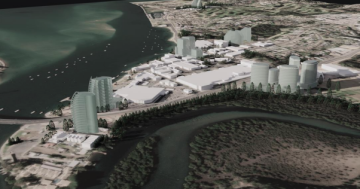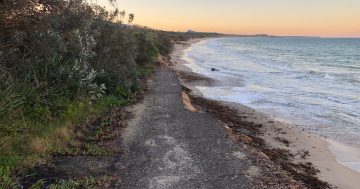
Bushfire near Cobargo in September this year. Photo: Bega Valley Rural Fire Service Facebook.
The highly anticipated and widely debated Bega Valley Shire Council draft Climate Change Resilience Strategy 2050 is available now and is open for public comment until December 15.
The draft document is not exhaustive but is not supposed to be at this stage, council’s Director of Community, Environment and Planning, Dr Alice Howe, says.
“The strategy is currently a high-level plan.”
“We are really keen to get other points of view to fill in some of the detail, there’s so much we can all be doing and it’s these direct actions which need to be expanded on in the draft.”
Council has identified seven areas of response to the climate emergency: protecting our natural systems; preparing for natural hazards; liveable and connected places, safe, active and liveable communities; diverse and thriving economy; energy security; and food security.
Across these areas, the document identifies areas of vulnerability and risk, ideas for local actions across the Shire, and a vision for success by 2050.
The two biggest climate-related risks in the Bega Valley are bushfires and sea-level rise, Dr Howe says.
“We are working on detailed modelling of flooding now and figures show that 18 square km of the shire could be affected by rising water by 2100 but we have 28 catchments to consider, so it takes time,” she says.
Resilence is characterised by diversifying, Dr Howe explains and that will include thinking outside the shire’s traditional income streams, although she stresses that the council’s role is to ask questions of stakeholders such as NSW Forestry and not to tell them how to do their job.
“At some point, using forests for carbon sequestration might be more valuable than the timber they now supply, or our industry might focus on selling blue carbon in the form of kelp beds. There is a lot of potential in using carbon credits to generate income.”
Council is also looking at the feasibility of pursuing state and federal funding to create climate-friendly industry, for example, a recycling plant.
The changing climate is already taking its toll on Bega’s famous dairy industry, struggling through yet another drought, and Dr Howe is sympathetic.
“Nobody wants to see dairy leave,” she says “but considering our options is what we have to do, that’s what resilience is, diversifying.”
There are ample opportunities around climate resilience, Dr Howe says.
“It came as news to me that there is one main power line into the town of Bega, which makes us vulnerable if that line is affected by a natural disaster. Installing multiple small banks of renewable power could address this problem.”
For those who feel anxious about the immediate effects of climate change, the strategy is not a magic answer and won’t help with undoing development plans that were agreed upon historically before climate change was widely accepted as a real threat.
“In terms of planning, we can’t retrospectively ask developers to comply with current legislation,” Dr Howe explains “council are not able to influence a lot of areas that we think will affect a climate-resilient future but what we can do is use an evidence-based approach and act on the best available information.”
Council encourages everyone to think about how they can contribute.
The draft Bega Valley Shire Climate Resilience Strategy 2050 is on exhibition for a minimum of 42 days from today – November 4. Click HERE to take a look and offer feedback.
After the public exhibition period, Council staff will prepare a further report to Council which will include information on the economic and legal implications of the strategy on economic and agricultural activity in the Shire.
Face to face meetings about the draft strategy are available on request.










